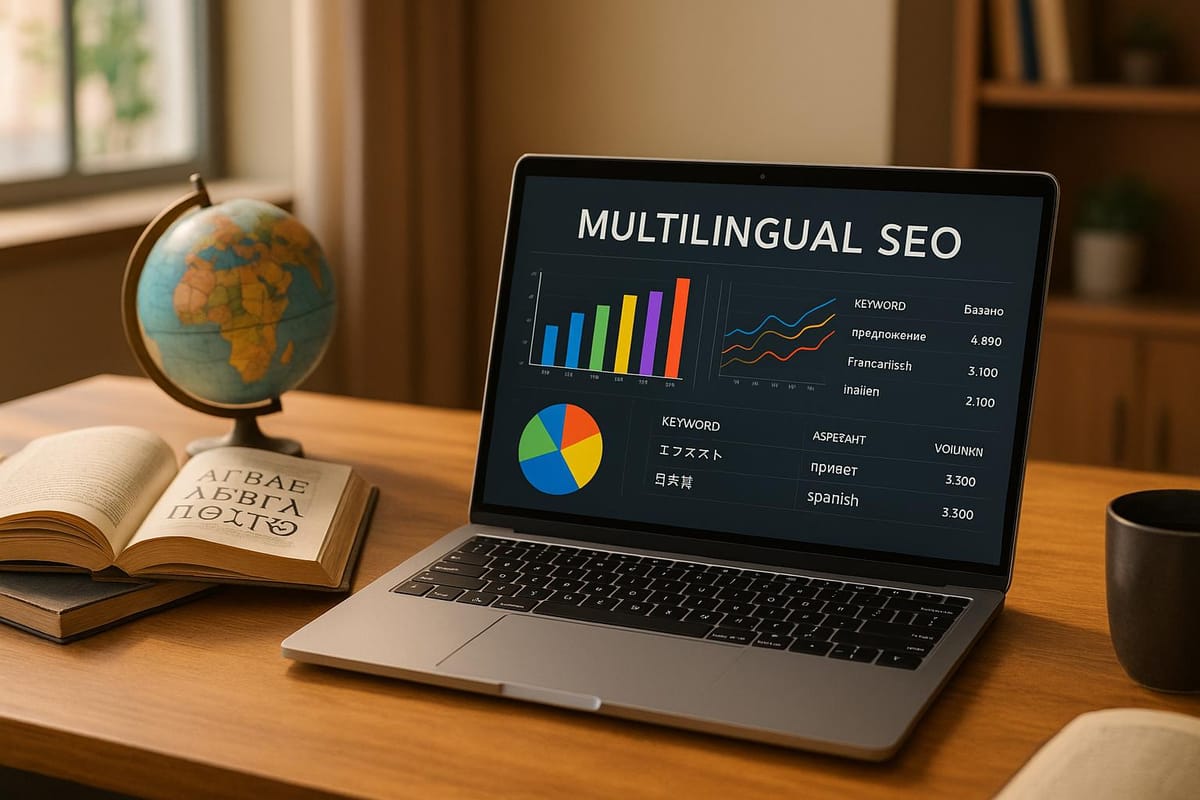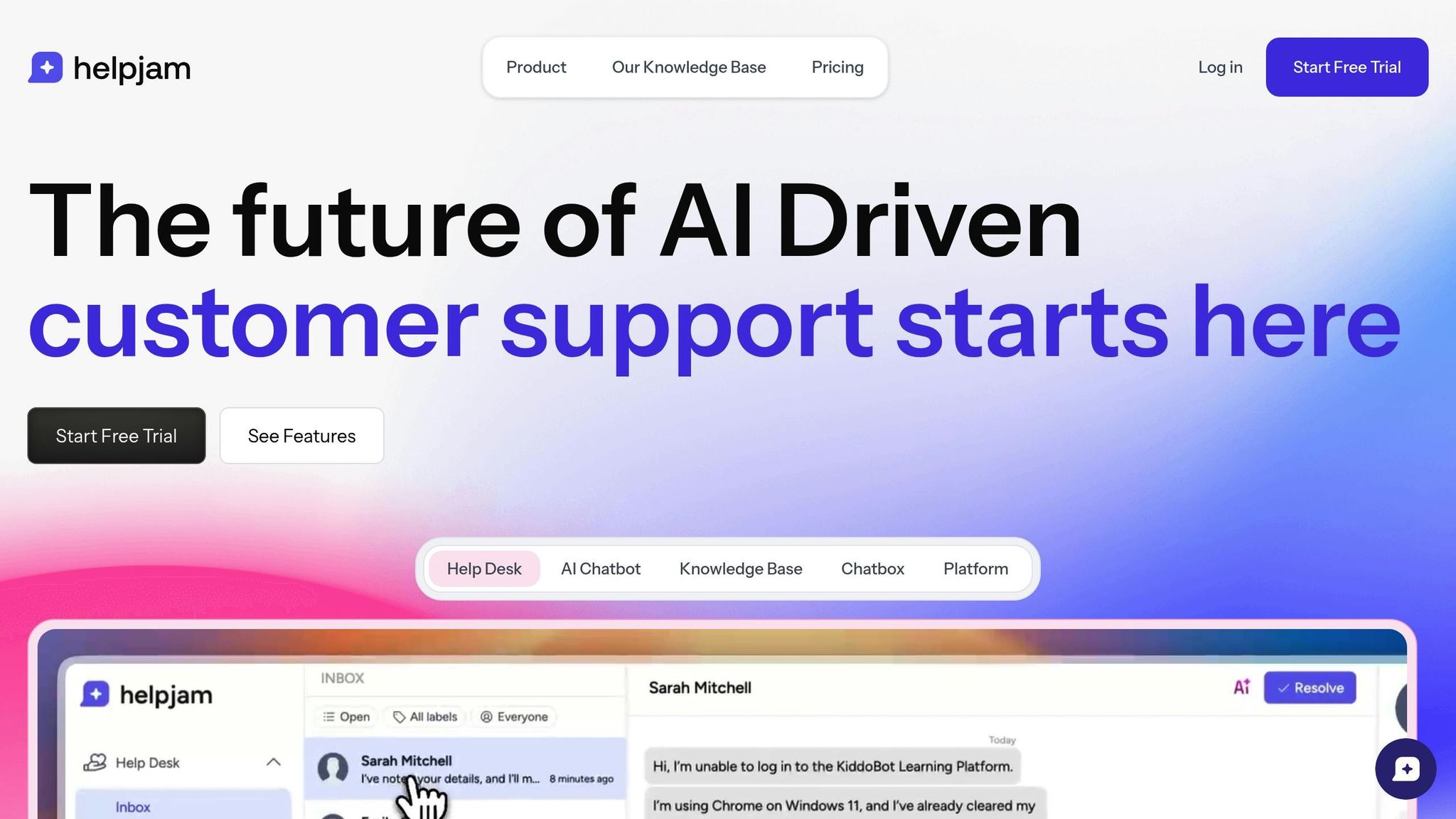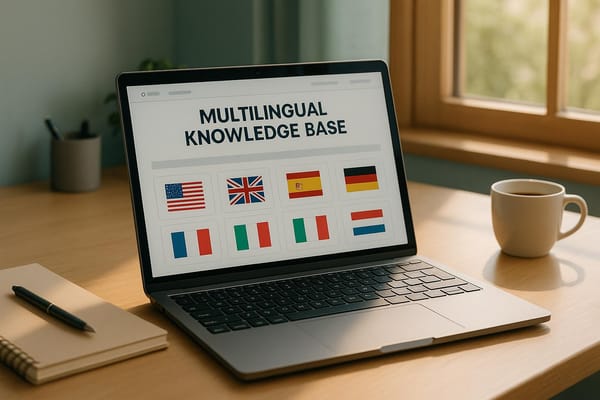How AI Improves Multilingual SEO for Global Brands
Explore how AI revolutionizes multilingual SEO for global brands by enhancing keyword analysis, translation accuracy, and content management.

AI makes multilingual SEO faster and more accurate. It helps global brands connect with international audiences by simplifying keyword research, content translation, and localization. Here's how AI transforms multilingual SEO:
- Faster keyword analysis: AI identifies keywords for multiple languages and regions in minutes, saving days of manual work.
- Context-aware translations: AI ensures translations maintain meaning, tone, and SEO value.
- Localized content optimization: Tailors content to local search habits and regional preferences.
- Efficient content management: Automates translation updates and scales to support many languages.
Quick Example: Tools like HelpJam use AI to translate and optimize knowledge base articles instantly, keeping SEO intact across markets.
| Aspect | AI Approach | Manual Process |
|---|---|---|
| Keyword Research | Analyzes thousands in minutes | Takes days or weeks |
| Translation Quality | Context-aware and SEO-friendly | Word-for-word, less precise |
| Localization Speed | Instant updates | Slower manual revisions |
| Content Gap Analysis | Automated insights | Requires detailed research |
AI simplifies multilingual SEO, making it easier for businesses to expand globally while staying relevant in local markets.
Multilingual Keyword Research with AI
AI-Based Keyword Analysis
AI tools dive into vast amounts of search data to pinpoint effective keywords tailored to different languages and regions. These tools go beyond just search volumes - they also factor in context and local preferences to deliver targeted results for each market.
When working on keywords for a knowledge base, AI tools can identify:
- Variations in regional dialects and language use
- Local search habits and behaviors
- Terms and phrases unique to specific cultures
This ensures your content stays relevant and optimized while keeping your messaging consistent across regions. It’s a more precise way to target keywords compared to older, less efficient methods.
AI vs Manual Keyword Research
When you stack AI-driven research against manual methods, the advantages are clear. AI tools handle multilingual keyword analysis in minutes, while manual research can take days - or even weeks.
Here’s a quick comparison of how AI changes the game:
| Aspect | AI-Powered Research | Manual Research |
|---|---|---|
| Processing Speed | Analyzes thousands of keywords in minutes | Takes days or weeks for thorough analysis |
| Language Coverage | Handles multiple languages at once | Focuses on one language at a time |
| Pattern Recognition | Instantly spots trends across markets | Limited by human capabilities |
| Content Gap Analysis | Automatically finds content opportunities | Requires detailed manual research |
| Update Frequency | Provides real-time data updates | Relies on periodic manual updates |
HelpJam’s platform quickly detects content gaps, making it easier to create targeted content. AI tools also assess search intent across different markets, ensuring your content ranks well and aligns with local user expectations. This sharper keyword analysis strengthens your content strategy, helping you succeed in global SEO efforts while tailoring content to local audiences.
Local Market Content Optimization
AI is changing the game for content localization by tailoring translations to fit regional specifics.
Meeting Local Search Intent
AI tools dive deep into local search data to figure out how people in different areas look for similar products or services. This process aligns content with local search habits and cultural expectations. For multilingual content, AI identifies variations in language, cultural subtleties, and region-specific keywords. By spotting customer search trends and content gaps, AI makes content optimization more precise and effective.
It also strikes a balance between maintaining a brand's identity and adapting to local needs. This ensures content aligns with search intent while staying true to the brand, which directly contributes to better SEO outcomes.
SEO Results of Localized Content
AI-driven localization has a much stronger impact on SEO performance than traditional translation methods. Content tailored with AI often leads to better engagement and higher search rankings because it resonates more with local audiences.
| Performance Metric | AI-Optimized Content | Traditional Translation |
|---|---|---|
| Search Visibility | Stronger local SERP performance | Limited to basic translations |
| User Engagement | Longer time on page | Lower interaction rates |
| Content Relevance | Fits local intent | May miss cultural nuances |
| Update Efficiency | Instant optimization | Slower manual updates |
| Language Accuracy | Context-aware translations | Word-for-word translations |
Managing Multilingual Content with AI
AI isn't just changing keyword research and local content strategies - it's also reshaping how businesses manage multilingual content.
AI Translation Management
AI has revolutionized the way multilingual content is translated. Modern AI systems analyze content structure, context, and intent to deliver precise, SEO-friendly translations. These tools ensure your brand's tone and terminology stay consistent across all languages while aligning with local search trends. This approach not only enhances translation accuracy but also boosts search visibility in different markets.
Time and Cost Benefits
Managing multilingual content with AI brings major time and cost savings compared to traditional methods. Automation simplifies translation and localization, cutting down on both time and resources.
| Aspect | Impact on Resources | Business Benefit |
|---|---|---|
| Translation Speed | Instant versus days | Faster market entry |
| Update Management | Automated across languages | Lower maintenance costs |
| Quality Assurance | AI-driven consistency | Fewer revisions needed |
| Content Creation | AI-assisted workflows | Higher productivity |
| Language Support | Scalable to many languages | Affordable global expansion |
These efficiencies make it easier for businesses to scale their multilingual content strategies.
HelpJam's Multilingual Features

HelpJam is a great example of how AI simplifies multilingual content management. Its AI-powered tools streamline content creation and translation, ensuring consistent messaging across languages.
"Work alongside your AI copilot as it helps craft your articles effortlessly. It continues writing until your next sentence and lets you create, translate, or rephrase entire pieces. With HelpJam, content creation becomes an enjoyable process." – HelpJam
HelpJam offers flexible language support tailored to business needs. The Growth plan includes support for 5 knowledge base languages, while the Business plan allows for unlimited languages. These features enable global brands to expand efficiently without compromising their SEO strategies.
Key features include:
- Instant translation across supported languages
- AI-assisted writing and rephrasing
- Fully translatable user interfaces
- Automated updates for all language versions
Regional Search Engine Requirements
Global search engines come with their own set of technical and cultural considerations. AI tools help navigate these complexities, ensuring your content stays visible across different regions.
Meeting Search Engine Standards
Localized content plays a key role in improving relevance, but meeting the specific criteria of each major search engine is just as important. Here's a quick overview of what they require and how AI tackles these challenges:
| Search Engine | Key Requirements | AI Optimization Approach |
|---|---|---|
| Mobile-first indexing, Core Web Vitals | Real-time monitoring and adjustments | |
| Baidu | Chinese language optimization, ICP license | Automated compliance with local standards |
| Yandex | Cyrillic character support, regional hosting | Language-specific fine-tuning |
| Naver | Korean language nuances, local link-building | Content tailored to cultural context |
AI systems handle these varied requirements efficiently, reducing the need for manual interventions. By focusing on these specific needs, AI ensures your content performs well across different search engines.
Regional SEO Performance Tracking
AI-powered tools make it possible to track SEO performance across multiple regional search engines at the same time. These systems provide real-time updates on search visibility, algorithm changes, multilingual performance, and technical compliance.
HelpJam’s AI-driven analytics take this a step further by identifying content gaps and refining strategies for specific regions.
With this data-driven approach, brands can:
- Spot new trends and adjust their content strategies accordingly
- Stay compliant with local requirements while scaling their operations effectively
Conclusion
This guide has shown how AI is reshaping multilingual SEO. AI tools are transforming the way businesses handle keyword targeting, content localization, and managing content across multiple languages.
Modern AI platforms now offer real-time translation and content optimization. For instance, HelpJam's AI Co-pilot can translate and optimize content instantly, maintaining SEO value and cutting out the delays of manual processes. This is especially helpful for businesses looking to expand into new markets quickly and efficiently.
With these tools, businesses gain access to instant, SEO-friendly translations, up-to-date market insights, and automated content updates.
HelpJam's multilingual knowledge base, for example, supports an unlimited number of articles and categories, ensuring that content stays optimized and visible in every market. This approach simplifies operations and helps achieve long-term SEO success.
"Deliver exceptional customer support using our AI Platform" - HelpJam
For global brands, AI-powered platforms have become essential. They make managing multilingual content easier while maintaining consistent visibility and local relevance. This levels the playing field, allowing businesses of all sizes to compete globally.
As search engines get better at understanding user intent across different languages, AI will continue to improve content optimization and management. This ongoing evolution helps brands tackle traditional localization challenges with ease and maintain their competitive edge in the global digital space.
FAQs
How does AI help ensure SEO-friendly translations that respect cultural differences?
AI plays a critical role in creating translations that are both SEO-friendly and culturally relevant. By leveraging advanced tools, businesses can adapt content to local languages while maintaining its search engine optimization. These tools analyze keywords, search trends, and cultural nuances to ensure translated content aligns with the preferences and behaviors of the target audience.
Additionally, AI streamlines the process by automating tasks like keyword integration and content adjustments, saving time while delivering high-quality, localized material. This ensures global brands can effectively connect with diverse markets without compromising their online visibility.
How does AI enhance multilingual content management for global SEO?
AI significantly improves multilingual content management by automating time-consuming tasks and ensuring greater accuracy. It enables cultural adaptation by tailoring content to resonate with diverse audiences, optimizes keywords for better search engine performance, and streamlines content management through smart tools that simplify updates and translations.
Compared to traditional methods, AI reduces manual effort, minimizes errors, and speeds up processes, making it easier for global brands to maintain consistent, high-quality content across multiple languages. This not only improves SEO rankings but also enhances user experience for international audiences.
How can AI tools help global brands optimize their SEO for different regions and cultures?
AI tools empower global brands to effectively optimize their SEO by addressing both technical and cultural nuances of regional search engines. They enable precise multilingual content adaptation, ensuring that keywords, tone, and messaging resonate with local audiences.
Additionally, AI streamlines content management by automating translation and localization processes, making it easier for businesses to maintain consistency across multiple languages. This ensures that brands not only meet the technical requirements of search engines but also connect with diverse audiences on a cultural level.





